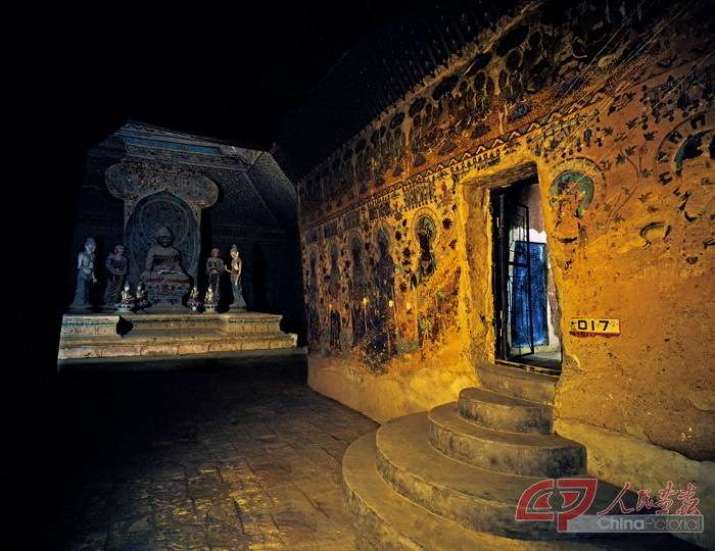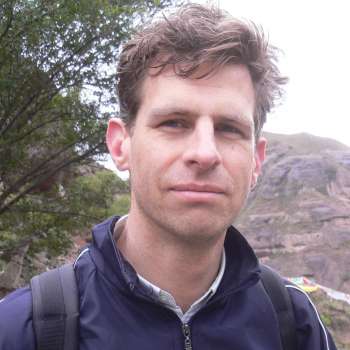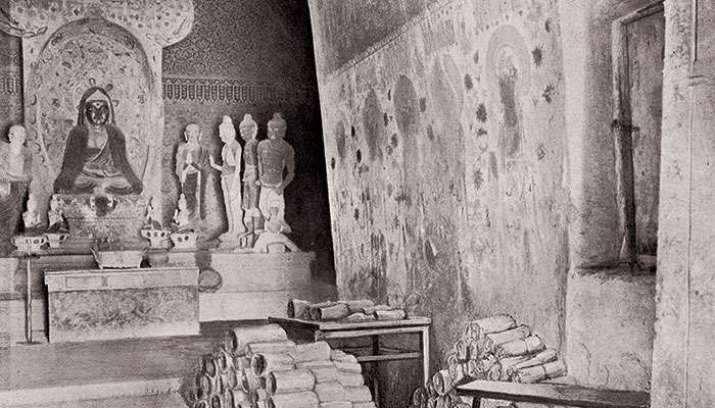
Buddhistdoor Global recently caught up with Sam van Schaik, an eminent scholar of Buddhist history, the Silk Road, and Tibetan Buddhism. He is presently head of the Endangered Archives Programme at the British Library, and is also well known for his work with the International Dunhuang Project, also based at the British Library. His PhD (2000) focused on Jigme Lingpa’s Dzogchen texts, and he has taught at the School of Oriental and African Studies (SOAS).
In this interview, van Schaik discusses a subject that he pioneered in one of his seminal books, Tibetan Zen: Rediscovering a Lost Tradition (2015), which is groundbreaking in its examination of texts spanning a period of Chan (Zen) presence and influence at the oasis kingdom of Dunhuang during the imperial Tibetan period. He recently published a new book, The Spirit of Zen (2018), with Yale Books.
Buddhistdoor Global: The Tibetan Zen practices described in the Dunhuang manuscripts you translated allude to a period of early proto-Chan (500–600 CE) through lineage accounts and records of teachings. As you noted, this is despite the fact that the date of their production is around the end of the Tibetan occupation in Dunhuang. Based on the genres of these texts—group initiation rituals, worldly rituals, recitation and meditation practices, notes and aids, amulets and talismans, and so on—do we have any certainty about whether these were Chinese Buddhist elites in the last days of a Tibetan governorship, Tibetan expatriates stationed in Dunhuang waiting to return home, or both?
Sam van Schaik: That’s a very interesting question, which involves two issues: first, who was using the manuscripts and practicing Chan in the Tibetan language, and secondly, what’s the relationship between the dates of the manuscripts and the texts they contain. As I say in the book, when we are looking at a manuscript or a collection of manuscripts, we ought to be thinking about the humans who created them and put them to use. With the Dunhuang manuscripts, there are frustratingly few clues. Just the fact that it was a multilingual community means that we don’t known whether the person who wrote, or commissioned a Tibetan Buddhist manuscript was from a Tibetan background rather than Chinese, Turkic, Khotanese, and so on. By the end of the Tibetan empire the distinction between “Chinese elites” and “Tibetan expatriates” had become blurred.
Some people had Tibetan personal names and Chinese surnames, and vice versa. People from Tibetan or mixed Sino-Tibetan backgrounds had been born and brought up in Dunhuang and similar towns in the region. And even for those without this Tibetan background, the Tibetan language had become a lingua franca for official communications as well as for transmitting Buddhist practices. And then there’s the question of dates. The manuscripts actually span the period from the last decades of the Tibetan imperial presence in Dunhuang (from the 820s through to the 840s) to the closing of the Dunhuang manuscript cave at the beginning of the 11th century.
The texts, including the Tibetan Zen texts, represent a long period of development, from the translation of lineage histories such as The Masters and Students of the Lanka (楞伽師資記), which were probably done during the imperial period in the eighth century, to the practice texts which merge Chan with tantric sadhana practice, which probably come from the 10th century.

BDG: In that case, well into the ninth and 10th centuries, Tibetan Zen seems to have predated the self-conscious construction of Chan lineages in 11th century China, which also coincides with the stirrings of the second diffusion and a more sectarian emergence of Tibetan Buddhist schools. Is there any way of tracing possible connections between Zen practice in Dunhuang and the consolidation of Chan historiography and lineage in China by the Northern and Southern dynasties and early Song?
SvS: The Dunhuang Zen texts—both Tibetan and Chinese—really do give us a different view of Zen from the one that emerged in the Song dynasty. This is why they’ve received so much attention from scholars from the early 20th century onwards—they really changed our understanding of the early history of the Zen tradition I think some of the explanations that people have used to explain the differences have been a bit simplistic though. For example, it has often been said that the Dunhuang Zen corpus represents the northern school of Zen, which was later replaced with the southern school. But if we look at the manuscripts themselves, teachers who are supposed to belong to both schools are there, often side by side. So in the book I caution against taking these “schools” too literally.
I think it’s important to understand that the manuscripts from the Dunhuang cave represent a local tradition—which is true for all manuscript collections. What we see happening in the Song dynasty is the creation of an “official” Zen, through standardizing lineage and teachings, which is a reflection of the increasing influence of Zen teachers at the Chinese imperial court. If we had other pre-Song dynasty Zen manuscript collections from other parts of China, they would no doubt also present a picture of another local Zen tradition, differing from the Zen of the Song, as well as that of the Dunhuang manuscripts. For instance, if it was from a community in southern China, we might see texts by Mazu, who does not appear in the Dunhuang manuscripts.
BDG: Several of the texts, such as A Brief Teaching on How the Six or Ten Perfections Are Included in Conceptual Meditation and Teachers and Students, are attributed to Moheyan, who was supposed to have represented Chinese Chan teachings, was defeated in a debate with Kamalashila, and then banished. Is it a simple accident of history that the nuances and tensions from Moheyan or the sudden enlightenment school was passed over by later Tibetan chroniclers, with the ideologically driven story of Trisong Detsen’s debate more politically useful by the time of the second diffusion?
SvS: I don’t think it was accidental that Moheyan’s position, as revealed by the Dunhuang manuscripts, was misrepresented in the later Tibetan tradition. There’s really only one story of the debate, which appears in the early history known as the Testimony of Ba and gets repeated by other Tibetan historians. And these were Buddhist historians who were mainly interested in presenting a coherent picture of how the Buddhism that came to Tibet was the real thing. In this narrative, Moheyan became a useful villain, representing a mistaken interpretation of the Buddha’s teaching on enlightenment being already present, which became associated with Chinese Buddhism in general. So the story of the debate served to underline a commitment to the gradual path that was favored by most of the scholastic writers of the histories, and it also made the point that India was source the home of the correct understanding of Buddhism and the source of the lineages of Tibetan Buddhism.
BDG: You note that Tibetan Zen lineages endured well into the 10th century and were still being mentioned in the 12th century. You list as one of the possible factors for Tibetan Zen’s decline the second diffusion’s aggressive promotion of India as the heartland of Buddhist teachings. Was another possible factor the rise of the Dzogchen and Mahamudra teachings within the new schools (more concerned with doctrinal distinctions), which are famously similar to the Zen teachings and might have made it difficult for Zen to differentiate itself?
SvS: I agree. In fact I think this is at least as important as the turn away from China and toward India in the second diffusion. Dzogchen and Mahamudra both forefronted the idea of the enlightened state being immanent and manifesting spontaneously and without effort, thus covering much of the same rhetorical ground as Zen. The major difference was that both Dzogchen and Mahamudra were based in tantric traditions, while Zen was based in the sutras. There are signs that Zen might have become better integrated into the world of Tibetan Buddhism.
For example, as I mention in the book, the Dunhuang manuscripts show that some people were incorporating Zen meditation techniques into deity yoga; it has also been suggested that Gampopa’s Sutra Mahamudra might have been influenced by Zen teachings. But since the Vajrayana featured so prominently in the graduated path that developed in Tibet, a sutra-based tradition like Zen was always going to be at a disadvantage compared with tantra-based traditions like Dzogchen and Mahamudra.

BDG: Chapter 10 of your book highlights texts outlining practices combining Zen and Tantric practices. You eschew the word “syncretism,” and note that these are transmissions that were less concerned with doctrinal distinctions than later schools. At some point, Zen and Mahayoga practices flourished together in a multicultural environment. Does this mean that the proto-Chan of the Dunhuang texts, perhaps like the early Buddhism of the Yarlung period, was much more “open” and “equanimous” about different teachings?
SvS: There were no schools of Buddhism in Tibet in the first diffusion of Buddhism, and if we look at the Dunhuang manuscripts, the question of lineage seems to be less important than it became in the second diffusion. Many of the manuscripts come from the period between the fall of the Tibetan empire and the introduction of new Indian lineages into Tibet, a period which seems to have seen a certain amount of experimentation. That said, I don’t think there is a complete difference in spirit from the following period.
Tibetans seems always to have been to trying to fit the multitude of teachings coming from India into structures that helped to classify them and put them into hierarchies for graduated practice, and we see this happening in the Dunhuang manuscripts with the formation of nine approaches to the path, which still exist today in the Nyingma. I guess the hardening of distinctions of school and doctrine came later, after the flood of new transmissions from India turned to a trickle and finally dried up. We can also link the increase in sectarianism to the political scene in Tibet from the 13th century onwards, when power came to be concentrated in certain schools of Tibetan Buddhism.
BDG: It would seem that the Zen of Dunhuang came rather close to a Buddhist medieval spirit of ecumenism, long before the concept even existed. Somewhat speculatively, are there any contemporary lessons Buddhists today could glean from this story of Zen at a Silk Road outpost with Chinese and Tibetan influences?
SvS: I will have to be very speculative, as it’s really not for me to give advice to other contemporary Buddhists! But I guess I feel that it’s good to combine one’s dedication to a particular tradition and practice with a broad and non-judgmental appreciation of the many manifestations of the Buddha’s teaching in the world. Our world is increasingly joined up, and the way that the approaches taken by the Buddhist inhabitants of a point of convergence on the multicultural Silk Road might just have something to teach us.
See more
The Spirit of Zen (Yale Books)
Tibetan Zen (Shambhala)












